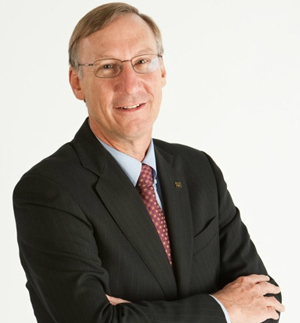Stephen Forrest receives IEEE Jun-ichi Nishizawa Medal for pioneering work in OLEDs
Forrest and colleagues received the award for “pioneering work on organic devices, leading to organic light-emitting diode displays.”

 Enlarge
Enlarge
Stephen Forrest, Peter A. Franken Distinguished University Professor of Engineering and Paul G. Goebel Professor of Engineering, is the co-recipient of the 2017 IEEE Jun-ichi Nishizawa Medal, along with Ching W. Tang and Mark Thompson, “For their pioneering work on organic devices, leading to organic light-emitting diode displays.”
The Jun-ichi Nishizawa Medal is given for outstanding contributions to material and device science and technology, including practical application.
In 1998, Prof. Forrest and Prof. Thompson demonstrated the first ultrahigh efficiency phosphorescent organic light-emitting diode (PHOLED), and have continued to advance the technology of OLEDs and phosphorescent OLEDs. Ching Tang, with Steven Van Slyke, demonstrated the first basic bilayer OLED structure at Kodak in 1987.
Phosphorescent OLEDs, are found in 1.5 billion smartphone and tablet screens and televisions worldwide, comprising a greater than $16B and rapidly growing display market. The use of organic materials over inorganic semiconductors used in traditional LEDs, makes it possible to have extremely thin, small, low cost and flexible displays – as seen in the Samsung Galaxy and Google Pixel smart phones, and LG OLED TVs, for example. OLED displays also tend to have sharper and more vivid colors, faster response times, truer images from different angles, and require far less power than their LED counterparts.
Phosphorescent OLEDs are also steadily encroaching into the domain of general lighting due to their 100% electron-to-emitted photon efficiency.
Prof. Forrest directs the Optoelectronic Components and Materials (OCM) Laboratory, where he and his group conduct research on OLEDs, as well as photovoltaic cells, and lasers & optics. His investigations in these areas span decades, and have resulted in five startup companies, 301 issued patents, and key technologies that are pervasive in the marketplace.
Within the past year, Prof. Forrest and his team achieved an efficient, deep, display quality blue using PHOLEDs that comes close to meeting the stringent brightness requirements of the National Television Systems Committee. His team also discovered a way to increase PHOLED efficiency by 50% for use in general lighting.
Prof. Forrest is a member of the National Academy of Engineering, the National Academy of Inventors, and the National Academy of Sciences. His numerous awards include: the IEEE Daniel E. Noble Prize for “innovations in organic light emitting devices”; the IEEE/LEOS Distinguished Lecturer Award; the IPO National Distinguished Inventor Award; the Thomas Alva Edison Award for innovations in organic LEDs; the Jan Rajchmann Prize from the Society for Information Display, and the Materials Research Society Medal “for pioneering contributions to the growth and optoelectronic applications of organic semiconductor thin films.” He is a Fellow of IEEE, the American Physical Society (APS), and the Optical Society of American (OSA). He has been named by Thompson Reuters top 1% of cited researchers in both physics and materials science.
About the IEEE Jun-ichi Nishizawa Medal
The IEEE Jun-ichi Nishizawa Medal was established in 2002 in honor of Jun-ichi Nishizawa’s lifetime of outstanding achievements ranging from fundamental semiconductor materials and devices through optical communication and power systems.
Considered the “Father of Japanese Microelectronics,” IEEE Spectrum recognized Nishizawa as one of the geniuses of the 20th Century.
Nishizawa was a professor, director of two research institutes and the 17th president at Tohoku University, Japan. He has received 28 national or international awards.
The award is sponsored by The Federation of Electric Power Companies in Japan.
 MENU
MENU 
